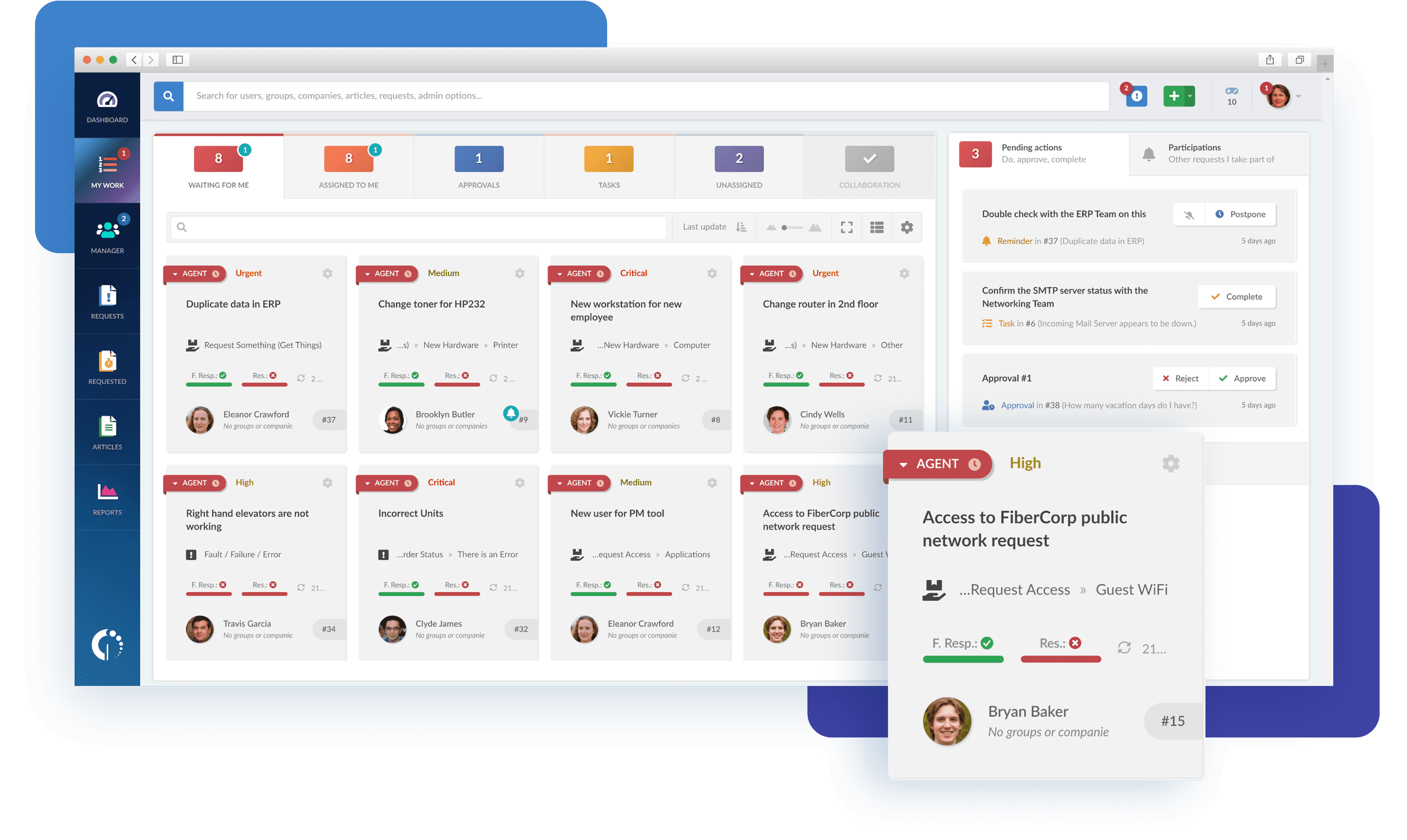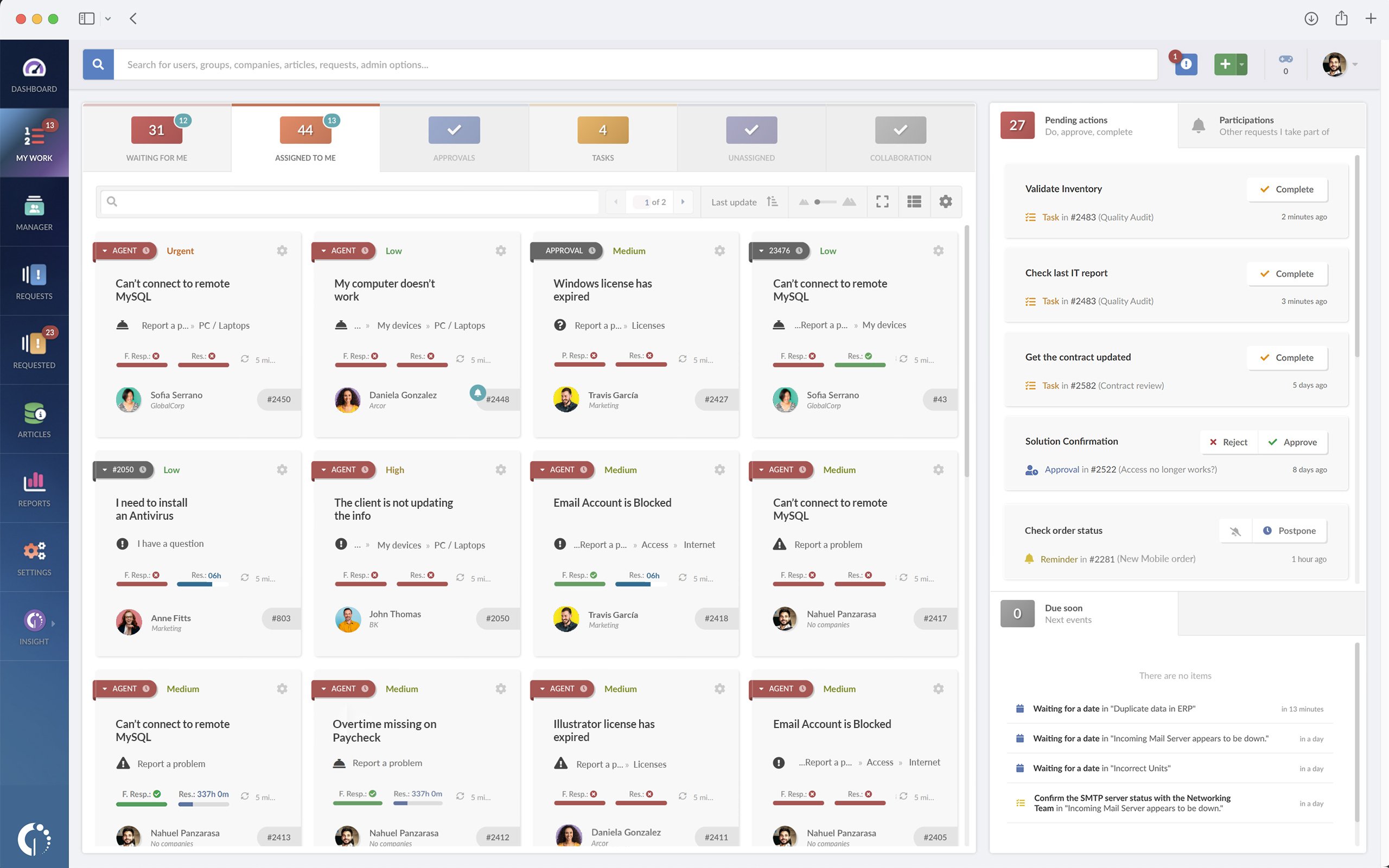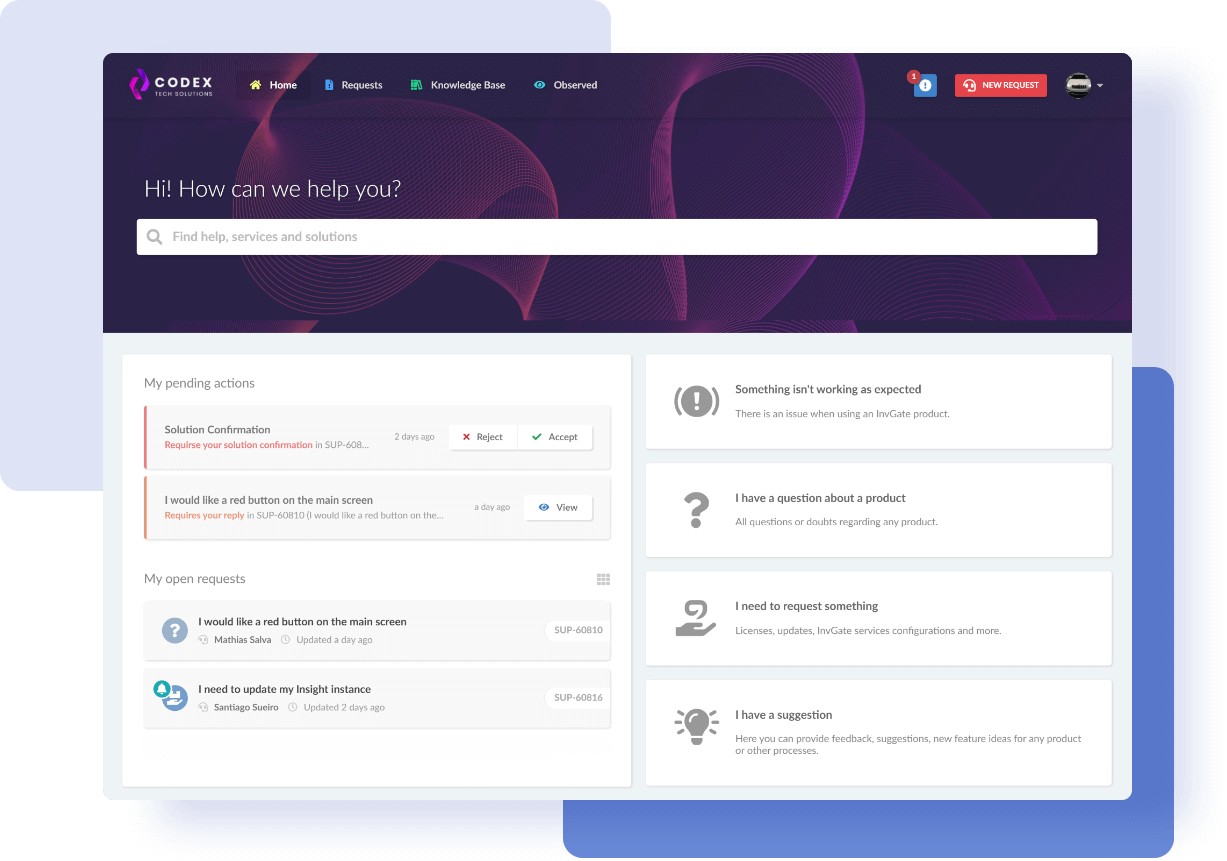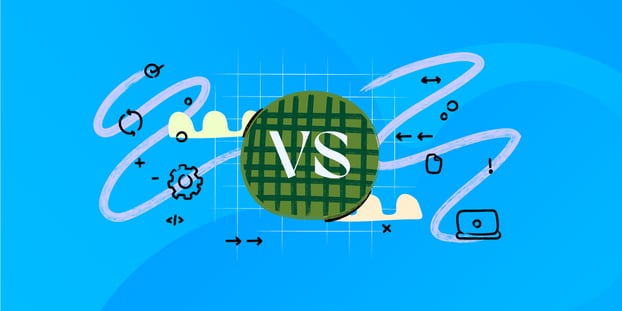Are you facing the complex challenge of selecting the ideal IT Service Management (ITSM) solution? If you're looking to compare TeamDynamix vs. Cherwell Service Management, you've come to the right place.
In this blog post, we’ll embark on a thorough ITSM tools comparison between these two platforms.
But that's not all - if neither of these platforms entirely aligns with your specific requirements, we have an alternative solution that might be your perfect match: InvGate Service Management. This robust platform offers an impressive array of features designed to streamline your service delivery and empower your organization.
Are you ready to explore these service desk software options and discover the perfect fit for your ITSM needs? Continue reading to unlock the insights you need.


Table of contents
- TL;DR
- What is TeamDynamix?
- What is Cherwell Service Management?
- Considering InvGate Service Management as an ITSM solution alternative
TL;DR
- TeamDynamix offers powerful dashboards and responsive customer support but faces challenges like complexities in Ticket Management, an outdated user interface, and reporting limitations.
- Cherwell Service Management's positive aspects include its user-friendly interface, extensive customizability, and Low-Code/No-Code approach. However, users dislike that Ivanti purchased it, and the company is now pushing towards Ivanti Neurons. In addition, they highlight performance issues and customization challenges.
- InvGate Service Management comes in as a strong option, offering a streamlined configuration and setup process using a no-code/low-code approach, exceptional user experience, a comprehensive support offering, and a cost-effective solution without compromising functionality.
We tried to be as thorough as possible, but if you don't have enough time to read it through and through, here's (another) TL;DR: InvGate Service Management can do everything we say here, and you can test it right away for free for 30 days.
Most looked-at features by buyers
When considering options for IT Service Management solutions, users tend to concentrate on specific features that align with their organization's requirements. Having a grasp of these desired features is crucial for making well-informed choices.
Let's closely examine the key factors that potential buyers usually consider when comparing ITSM tools.
- Support automation and Workflow Management - Buyers seek software solutions with automation capabilities to streamline routine tasks such as ticket routing, approvals, and escalations. These automation features contribute to increased efficiency and productivity.
- Cost and support - Buyers assess the overall cost-effectiveness of the solution, considering licensing models, subscription plans, and any additional expenses related to features or users. The availability of reliable customer support, comprehensive documentation, and accessible training resources significantly influences their decision-making.
- User-friendly experience and interface - Ease of use and the user interface's design are primary buyers' considerations. They highly value a user-friendly platform with an intuitive interface that enhances user adoption and overall productivity. Mobile accessibility is particularly crucial, especially for organizations with remote or mobile workforces.
- Ticket Management System - Prospective buyers emphasize having a robust Ticket Management system seamlessly integrated into their help desk software. This functionality allows for the efficient tracking, assignment, and resolution of customer inquiries and support requests.
- Adaptability - Buyers prefer software solutions that can be customized to align with their unique business needs. This ensures that the software accommodates their specific workflows and processes, ultimately increasing user satisfaction and operational efficiency.
- Seamless integration capabilities - The ability to seamlessly integrate with other systems and applications is a vital requirement for buyers. They value seamless data flow and automated processes, with a focus on the capability to integrate with existing tools and platforms to enhance efficiency and provide a unified user experience.
- Self-service portal and knowledge base - The inclusion of a self-service portal is highly regarded as it empowers end-users to independently address common issues and access relevant information without needing direct assistance.
- Scalability and customization - Organizations with evolving requirements prioritize solutions that can adapt to their growth and allow for customization. Buyers specifically look for the ability to create custom fields, workflows, and extensions/plugins to meet their unique business needs.
- Simplified IT service catalog - Many organizations seek a simplified IT service catalog with a centralized platform for users to request specific IT services or resources. This streamlines service requests, improves visibility, and aids in efficiently managing service delivery.
- Informative reporting - Buyers actively seek help desk software equipped with robust reporting tools, including dashboards and reports. These features provide valuable insights into IT operations and performance, facilitating informed decision-making and continuous service improvement.
- Efficient IT Asset Management - Users prioritize software that offers robust IT Asset Management capabilities, aiding in maintaining accurate inventories and optimizing resource utilization within their organizations.
- ITIL compliance - Many organizations prioritize adherence to ITIL (Information Technology Infrastructure Library) best practices. Therefore, buyers may favor solutions that support ITIL processes, including Incident Management, Problem Management, Change Management, and Asset Management.
What is TeamDynamix?
TeamDynamix is a cloud-based solution that provides services in the areas of IT Service Management, Project Portfolio Management (PPM), and Integration Platform as a Service (iPaaS), all delivered through a Software-as-a-Service (SaaS) model. This technology enables educational institutions such as colleges, universities, and other organizations to streamline, work together on, and enhance their operational processes.
What users like from TeamDynamix
TeamDynamix has garnered positive user feedback from reputable industry experts like Gartner, who have highlighted several notable strengths and advantages of the platform. Let's take a closer look at these benefits.
- User-friendly interface - TeamDynamix features an intuitive user interface that simplifies task assignment, management, and request submission. Users find it incredibly easy to navigate, enhancing their daily work efficiency.
- Dependable ticketing module - The ticketing module consistently receives praise for its stability and reliability. It equips users with efficient tools for organizing and tracking project tickets, which streamlines project management efforts.
- Customization options - Users appreciate the extensive customization options within TeamDynamix. These options empower them to tailor the platform precisely to their unique requirements, enabling the creation of customized workflows and processes.
- Responsive customer support - TeamDynamix's support team receives consistent accolades for their responsiveness and helpfulness. Users receive timely assistance when facing challenges or seeking guidance, contributing to a smoother overall user experience.
- Robust dashboards - The platform provides powerful dashboards that offer teams valuable management tools. These dashboards facilitate seamless monitoring and collaboration among team members, ultimately increasing productivity.
- Effortless implementation - TeamDynamix stands out for its straightforward implementation process, requiring no prior programming expertise. This accessibility makes it easy for organizations to get started with the platform.
What users don’t like from TeamDynamix
Although TeamDynamix has many strengths and positive qualities, it has not escaped criticism from its users, included in reviews from reputable sources such as Gartner. Let's explore the key issues that have arisen and deserve attention.
- Complex workflow structures - TeamDynamix has faced criticism for its intricate workflow structures, which have posed navigation and implementation challenges for some users.
- Ticket Management challenges - Users have encountered difficulties in managing tickets, including the inability to organize them by their due dates, issues with the workflow designer, and the absence of essential features like batch deletion in Asset Management.
- Integration with ITSM suites - Users have expressed frustration with the platform's inability to seamlessly integrate with a comprehensive IT Service Management (ITSM) suite. Additionally, they have noted a lack of robust Change and Configuration Management software.
- Complex user interface - TeamDynamix's user interface has been criticized for its complexity. Users have reported problems stemming from an outdated layout, limited customization options, and awkward ticket and comment arrangements. Many advocate for a more modern, user-friendly graphical user interface (GUI).
- Reporting limitations - Some users have found the system's reporting capabilities to be lacking. They desire deeper integration between project and ticketing applications to enhance their ability to create and analyze reports effectively.
- Limited desktop sharing and updates - Concerns have arisen regarding the platform's incapacity to facilitate desktop sharing and its infrequent updates once deployed. This limitation has constrained flexibility and usability for certain organizations.
- Permissions management challenges - Reports have surfaced about difficulties in how the vendor manages to write/view/access permissions. These challenges have resulted in concerns related to user access and security.
- Delayed enhancement addressing - Users have expressed frustration with extended wait times for enhancements to be addressed, affecting their ability to utilize the platform effectively.
- Limited support - A significant drawback that has garnered attention is the platform's inadequate support during critical outages. Users have reported feeling unsupported during crucial downtime situations. Furthermore, some have expressed dissatisfaction with the level of support provided through direct channels.
- Outage page accessibility - Requiring a login to access the outage page has been seen as an impediment, preventing users from obtaining critical information during system downtime.
- User experience enhancement needed - While generally considered user-friendly, some users have encountered challenges in their overall experience. Specifically, sorting and searching for tickets have been less intuitive, and the abundance of customization options has overwhelmed some users.
What’s TeamDynamix’s argument over Cherwell Service Management?
When examining TeamDynamix compared to Cherwell Service Management, it's crucial to explore the unique advantages that TeamDynamix offers as a robust ITSM solution.
- User-friendly interface - TeamDynamix offers an intuitive interface for streamlined task management.
- Powerful dashboards - TeamDynamix's robust dashboards enhance collaboration and productivity.
- Reliable ticketing - TeamDynamix's ticketing module is known for stability.
- Effortless implementation - TeamDynamix's easy implementation suits non-technical users.
- Customization options - TeamDynamix offers extensive customization, tailoring workflows precisely to needs.
- Responsive support - TeamDynamix's support is praised for responsiveness, contributing to a smoother user experience. This factor can be pivotal when choosing between the two platforms.
What is Cherwell Service Management?

Cherwell Service Management, developed by Ivanti, is an IT Service Management platform that effectively meets the needs of service departments without requiring coding or scripting. Its standout feature is its ability to provide automated IT service delivery through a comprehensive set of pre-built tools.
Cherwell Service Management offers several notable characteristics. It boasts a codeless architecture, enhancing adaptability for businesses. Additionally, it simplifies customization and streamlines processes by incorporating drag-and-drop functionality, along with encompassing Project Management capabilities.
Furthermore, Cherwell Service Management is language-friendly, offering support for multiple languages, and it provides deployment options as both a Software-as-a-Service (SaaS) solution and through on-premise deployment. It seamlessly integrates with Ivanti Neurons, a platform known for its predictive, self-healing, and autonomous remediation capabilities to enhance system performance and security.
What users like from Cherwell Service Management
Cherwell has received positive customer feedback, as evidenced by reviews from reputable sources such as Gartner. Here are some of the benefits that have been highlighted:
- Simplified development with low-code/no-code approach - Cherwell Service Management provides a low-code/no-code environment, allowing users to quickly establish and implement new features without requiring extensive coding knowledge or expertise.
- User-friendly interface - The platform offers an intuitive and user-friendly interface specifically designed to improve usability and simplify interactions with the system.
- Extensive customization capabilities - Users appreciate the wide range of customization options available within the platform. These options enable users to adapt various aspects of the system, including form fields and workflows, to align with their unique needs.
- Efficient automation and Workflow Management - The tool excels in automation capabilities, making it easy for users to create and implement intricate workflows tailored to their specific requirements.
- Seamless integration via APIs - Cherwell's support for API integrations ensures smooth connectivity with other systems, enhancing its overall functionality and enabling a seamless exchange of data and processes.
What users don’t like from Cherwell Service Management
Despite its strengths and positive aspects, Cherwell has received feedback from its user base expressing various concerns and dislikes regarding certain platform aspects. According to reviews from sources such as Gartner, here are some of the issues that have been highlighted:
- Emphasis on Ivanti after acquisition - Following Ivanti's acquisition of Cherwell Software, customers have voiced dissatisfaction with the increased promotion of Ivanti Neurons, an alternative platform. This shift in focus has not been well-received by Cherwell's existing customer base, leading to dissatisfaction among these users.
- Challenges in customization - While Cherwell offers extensive customization options, some users have encountered difficulties with specific development and customization tasks, especially when creating new Business Objects and Forms. These complexities have resulted in frustration and increased time investments.
- Performance concerns - Several users have reported performance issues, particularly when dealing with large databases or extensive groups of technicians. These performance problems can impact system responsiveness, leading to user frustration.
- Upgrade bugs and issues - Users have faced bugs and challenges during platform upgrades. In some cases, poorly planned releases have led to problems that require resolution, negatively impacting the user experience.
- Customer support critiques - The level of customer support provided by Cherwell has faced criticism from some users. Complaints include slow response times and a perceived reluctance to acknowledge software behavior as bugs. These issues have resulted in frustration and dissatisfaction with the support services.
- Outdated user interface - Certain users have found Cherwell's graphical user interface (GUI) to be outdated and less responsive, particularly when comparing the web version to the desktop application. This discrepancy in the quality of the user interface has generated dissatisfaction among some users.
What’s Cherwell Service Management’s argument over TeamDynamix?
Cherwell Service Management presents a compelling case when compared to TeamDynamix, and this argument can be summarized in several key points:
- Simplified development - Cherwell's low-code/no-code approach accelerates feature implementation, potentially outpacing TeamDynamix in speed and cost-effectiveness.
- User-friendly interface - Cherwell offers an intuitive interface for efficient user interactions, which may surpass TeamDynamix's usability.
- Extensive customization - Cherwell excels in customization, allowing users to tailor the system to their unique needs, whereas TeamDynamix may have limitations.
- Efficient automation - Cherwell's automation capabilities streamline workflows, potentially surpassing TeamDynamix in operational efficiency.
- Seamless integration - Cherwell's API support enhances connectivity with other systems, improving overall functionality. TeamDynamix may not offer the same level of integration.
Considering InvGate Service Management as an ITSM solution alternative

While TeamDynamix and Cherwell Service Management are widely recognized in IT Service Management, exploring alternative solutions to address your organization's unique requirements is crucial. In this context, InvGate Service Management is a compelling choice that deserves careful consideration.
Let's dive into the comprehensive features of InvGate Service Management that make it a valuable option for fulfilling your organization's ITSM needs:
Cost-effective solution
InvGate Service Management delivers a cost-effective solution without compromising functionality. It offers a comprehensive suite of ITSM features at a competitive price point, making it an attractive choice for organizations seeking affordability without sacrificing capabilities. In comparison to alternatives like TeamDynamix and Cherwell Service Management, InvGate Service Management strikes a balance between cost and functionality.
Outstanding user experience

InvGate Service Management places a strong emphasis on delivering an exceptional user experience through meticulous design and adherence to UI/UX best practices. Its intuitive interface promotes rapid adoption, reducing the need for extensive training and maximizing productivity.
Robust Ticketing and Incident Management

InvGate Service Management provides powerful capabilities for efficient ticket tracking, collaboration, and resolution. Features such as automated ticket routing, customizable workflows, and SLA Management empower IT teams to manage and prioritize incidents effectively.
Simplified configuration and setup
InvGate Service Management streamlines configuration and setup with a user-friendly, no-code/low-code approach. This approach allows both beginners and experienced users to implement the system without requiring extensive technical expertise. The platform offers straightforward configuration options, enabling organizations to leverage its robust ITSM capabilities quickly.
Strong self-service capabilities

InvGate Service Management offers robust self-service functionalities, including a user-friendly portal, an extensive IT service catalog, and a knowledge base. These features empower end-users to independently address common issues, access various IT services, and utilize self-help resources, thereby reducing the workload on IT staff.
Customization and flexibility
InvGate Service Management offers flexible deployment choices, allowing organizations to opt for on-premise or cloud-based solutions. This flexibility ensures that the platform can meet the specific requirements of diverse sectors and industries.
Comprehensive reporting and analytics

InvGate Service Management offers extensive reporting and analytics functionalities, allowing organizations to gain valuable insights into their IT operations and performance. The platform provides ready-to-use reports and customizable dashboards, enabling IT teams to analyze data, identify patterns, and make informed decisions to enhance their services.
Comprehensive Asset Management
By integrating InvGate Service Management with InvGate Asset Management, organizations gain a comprehensive view of their IT ecosystem, leading to improved service delivery and reduced downtime. InvGate Asset Management offers features such as IT Asset Discovery, Inventory Management, Software License Management, and maintenance schedules.
ITIL-certified readiness
InvGate Service Management holds the prestigious ITIL4 certification from PINK Elephant, highlighting its commitment to maintaining ITSM excellence. Whether organizations are beginning their ITIL journey or managing complex operations, InvGate Service Management offers a user-friendly and feature-rich experience aligned with industry best practices.
Focused on ITSM with ESM extension
InvGate Service Management is purpose-built for ITSM and seamlessly extends its capabilities to Enterprise Service Management (ESM). This empowers operational departments to enhance their processes and fully embrace the benefits of digital transformation. With a primary focus on ITSM and strong performance in ESM, InvGate Service Management facilitates streamlined workflows and comprehensive digital transformation initiatives across all departments.
Fast ROI and ongoing innovation
InvGate Service Management ensures a rapid return on investment through efficient implementation processes. Within weeks, organizations can start reaping the benefits of this robust ITSM solution. Additionally, regular feature updates keep users at the forefront of technology without incurring additional costs.
Next steps
In this in-depth comparison between TeamDynamix vs. Cherwell Service Management, we've examined both platforms, delving into their features, capabilities, and potential shortcomings.
However, the world of IT Service Management is a dynamic one, constantly evolving to meet the ever-changing needs of modern businesses.
One such compelling alternative worth serious consideration is InvGate Service Management. With its robust capabilities, extensive customization options, and a dedicated focus on streamlining IT operations, this platform presents organizations with a powerful tool to elevate their ITSM to new heights.
Download our free ITSM implementation checklist today! This roadmap will guide you through the next crucial steps for your organization, helping you optimize your ITSM strategy and propelling your business to new levels of efficiency and success.
















